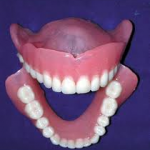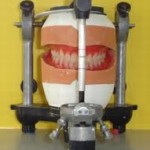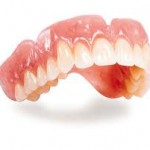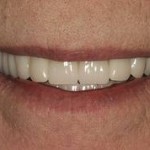Definition:
Preliminary insertion of complete denture wax up (trial denture) to determine the fit, esthetics, maxillomandibular relations —–etc.
Importance:
- It is the last opportunity to evaluate many of the previous steps already accomplished.
- It offers an excellent opportunity for patient education and facilitates the patient’s acceptance of the finished prosthesis.
Objectives:
1- To check and verify the established maxillomandibular relationship:
A) Verify that centric occlusion and centric relation coincide.
B) Test for the acceptance of the established vertical dimension of occlusion.
2- To determine if the positions of the teeth and the contours of the denture bases are compatible with the surrounding oral environment.
A) To verify the occlusal plane level relative to the ala-tragus plane horizontally.
B) To assess the posterior arch width as it relates to the mandibular residual ridge, modiolus area, and buccal corridor.
3- To verify tooth selection and arrangement for proper esthetics and phonetics.
4- To make additional interocclusal maxillomandibular records if needed for further adjustment of the articulator e.g. protrusive interocclusal record.
The various aspects of the try-in procedure:
- Extraoral examination of the trial dentures.
- Intraoral examination of the trial dentures.
Extraoral examination of the trial dentures
1- On the articulators
The mounted case is checked for:
a) Maintaining of the vertical dimension of occlusion
- Â Top of the incisal pin is flush with the upper member of the articulator.
- The incisal pin is in contact with the incisal table.
b) The mounting rings are firmly screwed in their position
c) Moving of the articulator smoothly from centric to eccentric positions without cuspal interlocking.
d) When the articulator is locked in centric, no other movements are permitted other than simple hinge movement.
e) The trial denture bases lie properly on their casts and the teeth meet evenly in centric.
f) If the case is mounted on the adjustable articulator, the sagittal and lateral condylar guides should coincide with the readings obtained from eccentric jaw relation records. These reading are better registered on the upper cast.
2) The master cast:
As the finished denture is processed on the master cast. So the master cast should be:
A) Has good shape.
B) Free from air bubbles or scratches.
C) Free from wax debris which lead to improper adaptation of the trial denture bases leading to false relationships.
D) If there are any undercuts present in the cast, these undercuts should be reviled to avoid scratching the cast by the trial denture bases.
3) The trial denture bases
Check the following:
- The trial denture bases must be stable.
- The borders of the trial denture base should be smooth, round, and have no sharp edges.
- Also the border should be shaped to conform to the depth and width of the sulci.
4) The teeth
1. The dentist responsibility to select the proper shade, and mould of the teeth to determine that the teeth is setted correctly.
2. Elimination of the excess wax to avoid the camouflages of the teeth relationships to overlook the occlusion.
3. The relation of both upper and lower teeth to the opposing ridges must be checked: if there is excessive anterior tooth contact on the articulator, should be corrected to avoid the excessive forces on the maxillary anterior ridge which causing bone destruction in that area that is already a target for bone loss.
4. Denture occlusion:
The occlusion of the teeth on the articulator should meet the following in the class I jaw relationship:
- The upper anterior teeth overlap the lower anterior teeth by about 1 – 2 mm, in both horizontal and vertical planes.
- The mandibular incisors do not protrude beyond the labial vestibule, and should present a curve when viewed from the occlusal surface this curve depends on the shape of the underlying alveolus.
- The lower posterior teeth should be set vertically on the ridge (not lingual to not interfere with the tongue), also the central grooves of mandibular posterior teeth should be on the crest of the ridge (better stability).
- The posterior end of the occlusal plane should be located at the junction between the middle and the distal thirds of the retro molar pad; also the height of the occlusal plane coincides with the line joining the incisal tip of the mandibular canine to the retro molar pad.
- Uniformly balanced occlusal contacts between the maxillary and mandibular posterior teeth, and maximum intercuspation between upper and lower posterior teeth when checked from both buccal and lingual aspects.
After being satisfied with the case on the articulator:
Intraoral examination of the trial dentures
To reduce the risk of cross- contamination, the trial denture should in a suitable antiseptic solution, washing in running water, before inserted in patient mouth.
1) Checking the trial dentures separately:
a) Trying- in the upper denture.
b) Trying- in the lower denture.
2) Checking the upper and lower dentures together.



